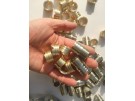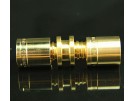Tech News
Thread repair is an important task for many machinists whether because the shop is taking in repair work or because a job needs to be reworked for some reason. Chasing threads on a manual lathe is no big deal because the machinist is completely in control of the process, but on a CNC many machinists are convinced it isn’t even possible.
The good news is that it is possible to chase threads on a CNC. In fact, it can even be easy as some machines have a built-in option to do exactly that. For machines that don’t have a built-in option to chase threads, it takes a little more work, and that’s what we’re here to talk about.
I’m going to walk through a few approaches discussed around the web, but let’s start from a basic assumption: the spindle is synchronized to the feed via an encoder (or index pulse for some lathes). That encoder is fixed, so our task is to find the fixed point the lathe is synchronized to and then perturb the tool tip using offsets until that point is tracking our thread properly. Let’s describe the situation from the viewpoint of a manual lathe. Let’s suppose you had a lathe where the splitnut could never be unlocked. You can vary the feedrate, but you can’t unlock. The tool will therefore always be synchronized at the same point. How would you go about chasing threads on such a machine?
Dialing the Threads in Visually
The most commonly suggested approach, is the following:
1. Program a thread cycle that will match your thread.
2. Chuck up your part, but set the machine up so the X offset is large enough it will only be cutting air–not the material.
3. Run the cycle very slowly and observe whether the tool is tracking the threads properly. Adjust the Z offset until it is.
4. When all is good, you’re ready to run the full thread cycle with the X offset such that the threads will be recut.
You’ll probably want a simple plunge cycle so you can see clearly that the tool tip is headed to the right spot.
This works reasonably well with large outside threads, but can be pretty difficult with small threads, ID threads, and threads that require very tight tolerances.
Seems to me you could make a probe macro based on this principle that ought to work pretty well and be very fast and automatic.
If it was me, I would combine these two methods and start with this approach and then do a quick visual check using the first approach to be sure everything looked lined up properly.












